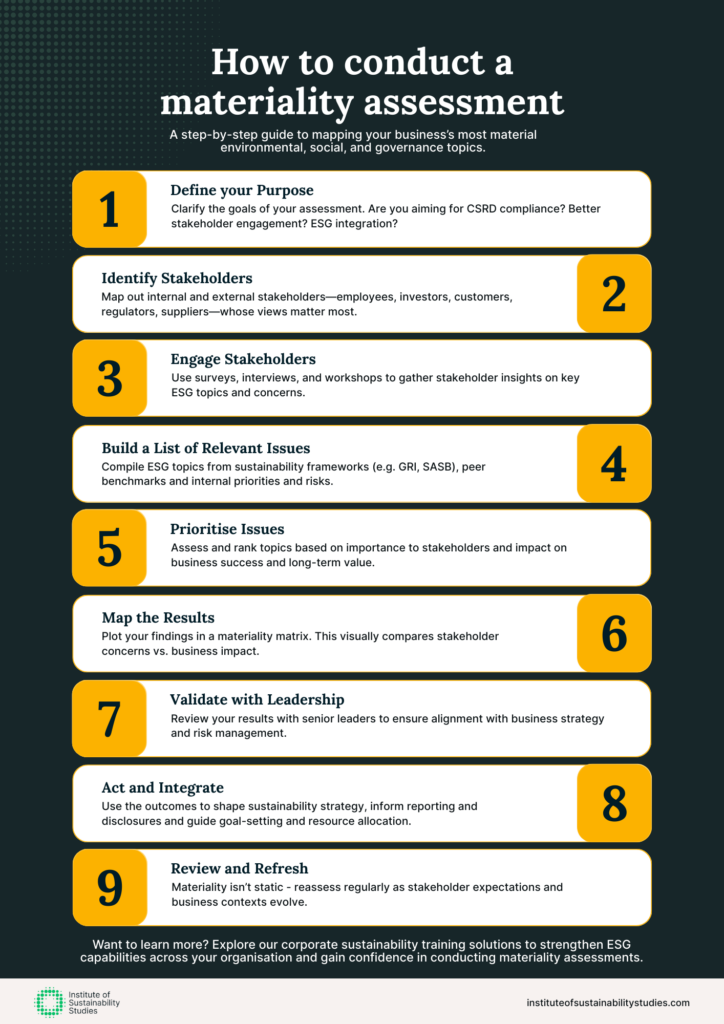The climate crisis is escalating, with the United Nations Environment Programme’s latest emissions gap report warning that nations must collectively achieve a 42% reduction in emissions by 2030 to preserve the Paris Agreement’s 1.5°C target. This urgent challenge places immense pressure on businesses to take meaningful action to reduce their environmental impact. But how can organisations ensure their corporate sustainability initiatives drive measurable and significant results? A materiality assessment offers a strategic pathway by cutting through complexity to identify the ESG issues most critical to business success and stakeholder priorities. Read on to explore how to conduct a materiality assessment in 6 steps.
What is a materiality assessment?
A materiality assessment is a strategic process used by organisations to identify and prioritise ESG issues that are most significant to their business operations and stakeholders. The goal is to focus on the topics that have the greatest impact on the organisation’s long-term success and sustainability. However, it also addresses the concerns and expectations of key stakeholders such as investors, customers, employees, regulators, and communities.
Benefits of conducting a materiality assessment report
Here are the main benefits of conducting a materiality assessment.
- Focuses on key priorities: A materiality assessment helps organisations identify and prioritise the most relevant ESG issues that align with their business objectives and stakeholder expectations.
- Improves stakeholder engagement: Engaging stakeholders, such as employees, customers, investors, and community members, during the assessment process builds trust and strengthens relationships.
- Enhances sustainability reporting: By identifying material issues, organisations can focus their reporting efforts on topics that are most meaningful to stakeholders and critical to the business. This increases the credibility and relevance of sustainability reports.
Gain practical skills to master materiality assessment and focus on ESG topics that matter most to your business and stakeholders
- Guides strategic decision-making: Materiality assessments provide insights into ESG risks and opportunities, helping businesses integrate sustainability into core decision-making processes. On top of that, it supports the development of sustainability strategies that align with long-term business goals and societal needs.
- Manages risk and enhances resilience: Identifying material ESG issues helps organisations anticipate and manage risks, such as regulatory changes, reputational damage, or climate-related disruptions. This proactive approach builds resilience and enhances the organisation’s ability to adapt to future challenges.
- Drives competitive advantage: Focusing on material issues positions organisations as leaders in sustainability, improving their reputation and differentiation in the market.
- Supports compliance and regulatory alignment: A materiality assessment ensures the organisation’s efforts align with current and emerging regulatory requirements and stakeholder demands.
How to conduct a materiality assessment: 6 key steps
A well-executed materiality assessment ensures that your organisation focuses on the ESG issues that matter most. Here’s how to conduct a materiality assessment in 6 steps:
1. Define the purpose and scope
Start by establishing the purpose of the materiality assessment. Why is it being conducted, and what does it aim to achieve? Once the purpose is clear, define the boundaries of the assessment by identifying which ESG issues will be evaluated and how they align with your organisation’s goals.
2. Identify relevant ESG issues
Compile a list of potential ESG topics most relevant to your organisation. Draw insights from sustainability frameworks such as the Global Reporting Initiative (GRI) and the UN Sustainable Development Goals (SDGs), industry benchmarks, peer reports, and stakeholder feedback. Use this research to create an initial list of ESG issues to assess.
3. Engage your stakeholders
Identify key stakeholder groups, including employees, customers, investors, suppliers, regulators, and communities. Use surveys, interviews, workshops, or focus groups to gather their feedback and understand which issues they prioritise and why. This ensures a comprehensive understanding of external and internal expectations.
4. Assess and prioritise issues
Evaluate the significance of each ESG issue by analysing its importance to stakeholders and its impact on your organisation’s success. Use materiality assessment tools like scoring matrices or heatmaps to visualise and rank the issues, allowing you to identify and prioritise the material ESG topics with the greatest relevance and impact.
5. Validate and finalise findings
Present your findings to senior leadership and key stakeholders for feedback. Cross-check prioritised issues against industry standards and benchmarks to ensure alignment with best practices. Finalise your materiality matrix or list of prioritised issues, ensuring it is accurate and reflective of both internal and external expectations.
6. Integrate and communicate results
Incorporate the prioritised material issues into your corporate strategy, sustainability reporting, and goal-setting processes. Share the findings with stakeholders through sustainability reports, presentations, or online platforms to demonstrate your commitment to addressing these issues and driving meaningful progress.
Gain a holistic understanding of sustainable business practices with an online, self-paced business sustainability course
Final thoughts
A materiality assessment is an invaluable tool for organisations striving to make a meaningful impact. By identifying and prioritising the ESG issues that matter most, businesses can streamline sustainability initiatives, foster deeper stakeholder engagement, and enhance their resilience in an increasingly complex global landscape.
This process is pivotal for driving meaningful environmental and social progress. With growing demands for corporate accountability, a well-executed materiality assessment is no longer optional; it is essential. Explore our online business sustainability training programmes to gain the expertise needed to embed impactful sustainability measures that benefit both your organisation and the planet.

With a strong background in environmental policy, Nazia is dedicated to driving sustainability and fostering partnerships for a brighter and greener future. She actively engages in crafting pivotal policy submissions directed to the European Commission as a member of the Zero Waste Alliance of Ireland.
She supports upcycling initiatives and is an advocate for ‘reduction’ over ‘recycling’ and ‘reuse’.
- Nazia Naheed Husainhttps://instituteofsustainabilitystudies.com/insights/author/nazia/
- Nazia Naheed Husainhttps://instituteofsustainabilitystudies.com/insights/author/nazia/
- Nazia Naheed Husainhttps://instituteofsustainabilitystudies.com/insights/author/nazia/
- Nazia Naheed Husainhttps://instituteofsustainabilitystudies.com/insights/author/nazia/









